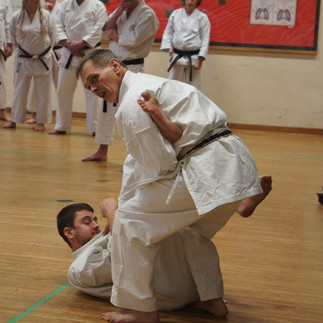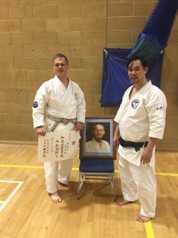Sensei Rob Howells Wado-ryu Course - February 2018
- Sensei Andy Gillies
- Feb 3, 2018
- 3 min read
Continuing our practice of exploring other fighting systems and styles of karate our first course of the year was a look at Wadoryu taken by Sensei Rob Howells at our usual venue of Hastingsbury School, (now known as Kempston Challenger Academy). It was really good that everyone arrived punctually and had signed in by 2.30pm allowing us to get on and maximize the time we had.
The afternoon began with Renshi introducing Rob Howells Sensei, who talked briefly about his personal karate history, commenting that he has been training for almost 50 years. He also briefly talked of his Sensei M Shiomitsu, 9th Dan, who sadly has had a severely debilitating stroke and to whom he was going to generously donate his fee for teaching us. He moved on to talk of the origins of the style of Wadoryu. The originator of the style was Ōtsuka Sensei who first registered his style in 1938, and was then called Shinshu Wadō-ryū Karate-Jūjutsu, a name that reflects its hybrid origins and character. Ōtsuka was a licensed a student of Yoshin-ryu when he first met Gichin Funakoshi. After having learned much from Funakoshi he then trained with other Okinawan masters such as Kenwa Mabuni and Motobu Choki. Ōtsuka Sensei merged Shindō Yōshin-ryū with Okinawan karate. The result of Ōtsuka's efforts is Wadō-ryū Karate which means the way of harmony.
To the untrained Wadō-ryū looks very similar to other styles of karate particularly Shotokan because of the early influences of the Okinawan masters under whom he had trained. Most of the underlying principles however were derived from Shindō Yōshin-ryū. A block in Wadō-ryu may look much like a block in Shōtōkan, but they are executed from different perspectives. Wadō-ryū focuses more on tai sabaki from an early grade and is a key element of its teachings - even more so than Shotokan which introduces it only when we start training in Jyu-ippon at a later grade. The Japanese term, taken to mean body evasion, can be translated as body-management, and refers to body manipulation, so as to move the defender, as well as the attacker out of harm's way.
After a very interesting and enlightening introduction by Sensei Howells, he handed back to Renshi who took us through some brief stretches and warm ups. We then moved on to Heian Godan with its deep stances and strong basic moves. After performing the kata a couple of times, Renshi handed back to Sensei Howells for the remainder of the day. He began by explaining that we were to learn Pinan Godan and that Pinan means calm and peaceful, godan as with us, level five. Slowly, a move and a sequence at a time, we built the kata until we could all get through it with varying degrees of competency. We were soon pairing up taking techniques and sequences from the kata and practicing as kumite. Here we were expected to 'feel' the technique and to utilise tai-sabaki rather than to perform the moves as we do in basic Shotokan kata. We looked at a great deal of the bunkai even if it was not all practiced with our partner. This gave, especially the higher grades, a chance to compare the similarities and differences between two very closely linked styles of karate. The first part of the afternoon concluded with everyone performing Pinan Godan medium speed in a relaxed manner.
After a short break, we resumed to experience some Wado-ryu Ippon kumite which, even though it wasn’t too different from our Kihon and Jyu-Ippon, was an interesting insight into another style, another way. We then moved on to block and counter double techniques (rengeri and renzuki) and a combination of both punches and kicks. Judging by the noise, both the juniors and the seniors were making a great time was had by all.
Sadly, as with all our courses and seminars, the time ran out all too quickly. Sensei Howells concluded the afternoon with a brief question and answer session which caused a great debate amongst the juniors about the benefits of a good kiai. This in fact led in to a competition based on a Ken-do exercise on the art of kiai between adults and juniors. The afternoon finished with our traditional group photo which was followed by presentation of attendance certificates and we all bade farewell.
Thank you, Sensei Howells. No doubt we shall see you again soon. Domo arigatou. Osu!
RECENT UPDATE TO THIS ARTICLE - 20th February 2018
Many congratulations to Sensei Robert Howells, who was awarded 7th Dan by 3rd Grand Master of Wado Ryu (and grandson of the founder) Hironori Ōtsuka III on Saturday 17th February. This is a very-well deserved achievement, culmination of a lifetime’s study of Wado Ryu Karate. Proof of Rob’s ability, knowledge and understanding comes across in the teaching of his style.














































Comments